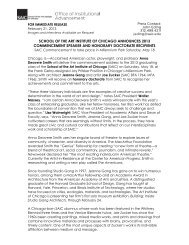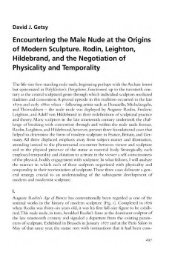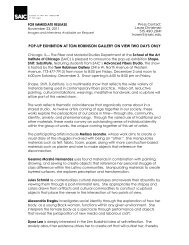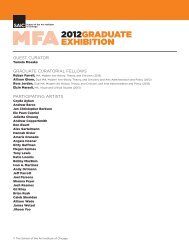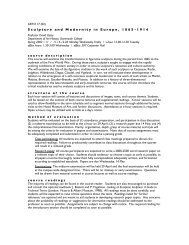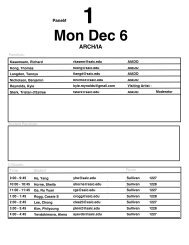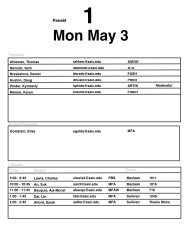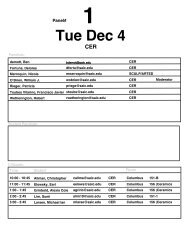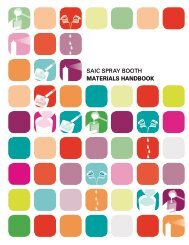i. institutional support and commitment to continuous improvement
i. institutional support and commitment to continuous improvement
i. institutional support and commitment to continuous improvement
Create successful ePaper yourself
Turn your PDF publications into a flip-book with our unique Google optimized e-Paper software.
School of the Art Institute of Chicago<br />
Department of Architecture, Interior Architecture, <strong>and</strong> Designed Objects<br />
Master of Architecture<br />
Master of Architecture with emphasis in Interior Architecture<br />
projective apparatus for identifying <strong>and</strong> providing opportunities for students <strong>and</strong> faculty in the<br />
department, linking the “day <strong>to</strong> day” <strong>to</strong> the “year <strong>to</strong> year.” It is the practice of the AIADO <strong>to</strong> allow<br />
for a carefully moni<strong>to</strong>red but flexible application of the departmental mission; consequently,<br />
departmental procedures balance the requirement <strong>to</strong> deliver vital objective educational content with<br />
an openness <strong>to</strong> new idea trends, teaching methods, material investigation, <strong>and</strong> project deliverables.<br />
An extremely useful <strong>to</strong>ol in the planning <strong>and</strong> assessment process for curricular, faculty placement,<br />
<strong>and</strong> learning culture issues is SAIC course evaluation process.<br />
Since March 2007 in particular, changes in the content of the required Architectural His<strong>to</strong>ry classes<br />
for the MArch program were proposed in the student evaluations, <strong>and</strong> quickly brought <strong>to</strong> the<br />
department’s <strong>and</strong> Dean’s attention. This resulted in the revision of the titles <strong>and</strong> content of courses,<br />
<strong>and</strong> the augmentation of the 2007 full-time search for new Design <strong>and</strong> Architectural His<strong>to</strong>ry faculty<br />
members, which yielded two design his<strong>to</strong>rians hires. In 2007, architectural design his<strong>to</strong>rian Kai Wood<br />
Mah was hired, <strong>and</strong> in 2008 SAIC made two additional appointments in <strong>support</strong> of the Architecture<br />
programs: design his<strong>to</strong>rians Michael Golec <strong>and</strong> Christine Atha.<br />
In Spring 2007, student evaluations recommended a more effective integration of SAIC’s<br />
professional structural engineering teaching partners. SAIC is committed at the highest<br />
administrative level <strong>to</strong> forming effective partnerships with Chicago’s engineering community. The<br />
Master of Science in His<strong>to</strong>ric Preservation degree program relies on this kind of expert partnership.<br />
In the MArch program, professional structural engineers who are not full-time faculty are teaching<br />
basic statistics <strong>and</strong> structural design. To better integrate <strong>and</strong> clarify this instruction, as well as <strong>to</strong><br />
address the March 2007 Visiting Team’s report, a new form of class was designed: the “integrated<br />
technical practice” class. This kind of class now brings <strong>to</strong>gether generalist “integrating” architects<br />
<strong>and</strong> experts with engineering expertise in<strong>to</strong> the same class <strong>to</strong> guarantee the underst<strong>and</strong>ing <strong>and</strong><br />
integration of the technical material.<br />
In 2009, course evaluations <strong>and</strong> student interviews revealed a desire in the first year cohort <strong>to</strong><br />
receive more training in the development of representational skill, digital <strong>to</strong>ol use, contemporary<br />
software, <strong>and</strong> CN controlled fabrication—particularly as this skill accrual can be applied <strong>to</strong> current<br />
studio projects. This led <strong>to</strong> the creation of a greater number of technical electives including AIADO<br />
2915 Spatial Computer Imaging: Vec<strong>to</strong>rwork (Rhino/Grasshopper) in Spring 2010 <strong>and</strong> AIADO 2915<br />
Spatial Computer Imaging: Revit <strong>and</strong> AIADO 2915 Spatial Computer Imaging: Au<strong>to</strong>CAD in Fall<br />
2010. Greater emphasis in these <strong>to</strong>pic areas has appeared in the required pre-program summer<br />
intensive classes <strong>and</strong> the integrated technical practice classes as well. Also, two graduate Teaching<br />
Assistantships for six hours per week were added, providing tech-savvy, one-on-one peer tu<strong>to</strong>ring<br />
for students in 2009–10 <strong>and</strong> 2010–11.<br />
2) Additional planning procedures/initiatives<br />
A useful <strong>to</strong>ol in the planning <strong>and</strong> assessment process for both curricular <strong>and</strong> learning culture issues is a<br />
reliable schedule of meetings <strong>and</strong> information collection <strong>and</strong> dissemination procedures, including:<br />
o The three program direc<strong>to</strong>rs (Undergraduate Architecture/Interior Architecture;<br />
Graduate Architecture/Interior Architecture; <strong>and</strong> Undergraduate <strong>and</strong> Graduate Designed<br />
Objects) attend SAIC Department Heads meetings, organized by the Deans Office <strong>and</strong><br />
attended by over 50 faculty <strong>and</strong> key staff. This meeting is the opportunity for the AIADO<br />
department <strong>to</strong> receive <strong>and</strong> deliver information relevant <strong>to</strong> departmental planning within<br />
the larger institution. Reports on issues germane <strong>to</strong> the AIADO department are delivered<br />
<strong>to</strong> faculty in departmental meetings.<br />
o Three regular faculty meetings per term, where all AIADO faculty, full- <strong>and</strong> part-time,<br />
meet <strong>to</strong> discuss AIADO planning issues that affect general departmental administration.<br />
o One <strong>to</strong> three special session faculty meetings per term, where full-time faculty<br />
Architecture Program Report | 28



